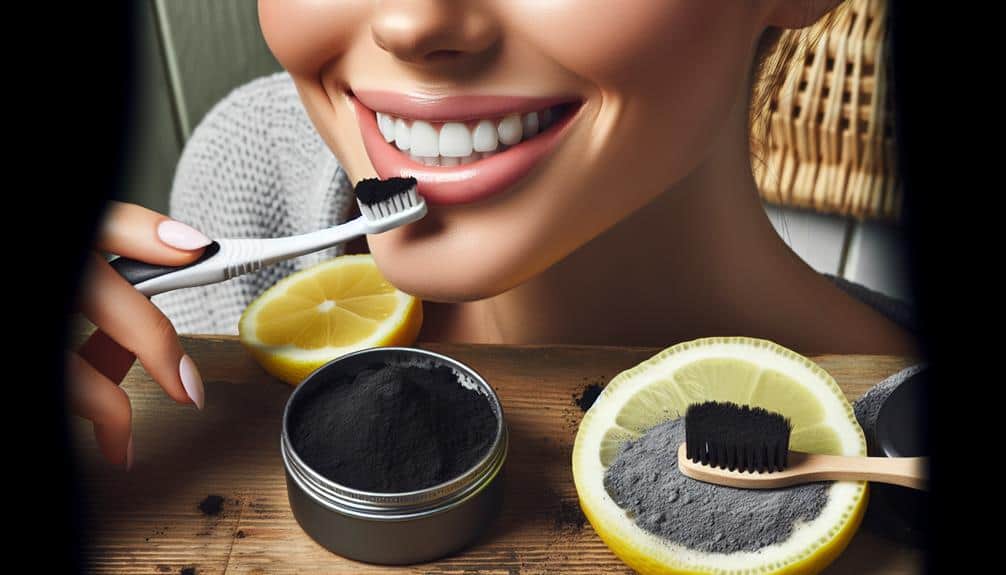Accelerate your teeth whitening process by utilizing Blue LED light, which activates chemicals in whitening agents and penetrates enamel effectively. This light promotes the release of reactive oxygen species, ensuring thorough whitening results. For a deeper understanding of various light sources that enhance teeth whitening, discover the benefits of UV light safety measures, red light therapy potential, and natural light sources for whitening.
Key Points
- Blue LED light accelerates whitening by activating whitening agents and penetrating enamel effectively.
- UV light boosts whitening process but requires protective eyewear and adherence to timer settings.
- Red light therapy enhances results, improves gum health, and reduces inflammation during whitening.
- Laser teeth whitening risks include sensitivity and enamel damage if not used cautiously.
- Natural light sources like sunlight and fruit peels can also aid in whitening teeth effectively.
Blue LED Light Benefits
Blue LED light benefits include accelerating the teeth whitening process by enhancing the effectiveness of whitening agents. This is due to the Blue light effectiveness in activating certain chemicals within the whitening agents, which in turn speeds up the breakdown of stains on the teeth's surface. LED technology benefits go beyond just enhancing the whitening agents; it also helps to penetrate the enamel more effectively, leading to better and longer-lasting results.
The Blue light effectiveness works by promoting the release of reactive oxygen species from the whitening agents, which then targets the discolored molecules in the teeth. This process helps break down these molecules, resulting in a brighter smile. LED technology benefits further amplify this effect by ensuring a more uniform distribution of light across all teeth, ensuring consistent and thorough whitening.
UV Light Safety Measures
To guarantee the safe utilization of UV light in teeth whitening procedures, it's imperative to implement stringent safety measures. When using UV light for teeth whitening, always remember the following:
- Protective Eyewear Precautions: Prioritize the use of protective eyewear to shield your eyes from the potentially harmful effects of UV light exposure. Proper eyewear helps minimize the risk of damage to your eyes during the whitening process.
- Timer Settings for Effectiveness: Adhere to recommended timer settings to ensure the effectiveness of the UV light in whitening your teeth. Following the specified time guidelines not only enhances results but also minimizes the risk of overexposure.
- Regular Maintenance of Equipment: Regularly check and maintain the UV light equipment used for teeth whitening to guarantee its safety and effectiveness. Proper maintenance helps prevent malfunctions that could lead to unintended exposure or ineffective whitening results.
Red Light Therapy Potential
Consider exploring the potential benefits of red light therapy in enhancing teeth whitening results and overall oral health. Red light therapy has been gaining attention for its various applications, including dental benefits and skin rejuvenation. When used in conjunction with teeth whitening treatments, red light therapy can potentially accelerate the whitening process by promoting blood circulation in the gums, reducing inflammation, and aiding in tissue repair. Additionally, the therapy's ability to stimulate collagen production may contribute to healthier gums and overall oral health.
Studies have suggested that red light therapy can help improve gum health by reducing bacteria and inflammation, which are common contributors to gum disease. By targeting specific wavelengths of light to the oral tissues, red light therapy has the potential to not only enhance teeth whitening results but also promote healing and regeneration in the mouth.
Laser Teeth Whitening Risks
What risks are associated with laser teeth whitening treatments?
Laser teeth whitening, although effective, comes with some potential risks that you should be aware of before undergoing the procedure. Here are some key points to take into account:
- Laser Precautions:
Laser teeth whitening involves the use of concentrated light beams to whiten teeth. While this method is generally safe when performed by a trained professional, there's a risk of potential damage to the gums and surrounding tissues if the laser isn't used correctly. It's important to make sure that the person administering the treatment is experienced and follows all safety protocols.
- Dental Sensitivity:
One common side effect of laser teeth whitening is increased dental sensitivity. The heat generated by the laser during the whitening process can sometimes cause temporary sensitivity in the teeth. This sensitivity may manifest as discomfort when consuming hot or cold foods and beverages. It usually subsides after a few days, but it's crucial to discuss this potential side effect with your dentist beforehand.
- Overuse Risks:
Excessive use of laser teeth whitening treatments can lead to enamel damage and increased tooth sensitivity. It's vital to follow the recommended guidelines for the frequency of treatments to avoid these risks and maintain good oral health.
Natural Light Sources for Whitening
When seeking natural light sources for teeth whitening, explore the benefits of sunlight exposure on dental aesthetics. Sunlight contains ultraviolet (UV) rays that can help whiten teeth by breaking down stains and discoloration. However, it's crucial to exercise caution and not overexpose your teeth to sunlight, as excessive UV exposure can lead to oral health issues.
Another natural method for teeth whitening involves fruit peels techniques. Fruit peels, such as orange or banana peels, contain natural compounds like d-limonene and potassium that can help whiten teeth. Simply rub the inner part of the fruit peel on your teeth for a few minutes daily to see potential whitening effects over time. While fruit peels may offer mild whitening benefits, they aren't as potent as professional whitening treatments or whitening toothpaste.
Frequently Asked Questions
Can Teeth Whitening Treatments Using Blue LED Light Be Harmful to the Enamel of the Teeth?
To safeguard your enamel during teeth whitening with blue LED light, guarantee proper application and duration. Blue light typically emits low levels of UV, minimizing enamel damage risk. Follow professional guidelines for safe and effective treatment.
Are There Any Long-Term Side Effects Associated With Using UV Light for Teeth Whitening?
Using UV light for teeth whitening can have potential long-term effects on enamel and gum health if not used properly. Safety precautions like protective eyewear and proper application help minimize risks associated with UV exposure.
How Does Red Light Therapy Potentially Enhance Teeth Whitening Results Compared to Other Light Sources?
When it comes to enhancing teeth whitening results, red light therapy shines bright. Its benefits include increased effectiveness. Remember to take precautions for tooth sensitivity. Red light's power may just be the key to your brighter smile.
What Are the Potential Risks or Complications Associated With Laser Teeth Whitening Procedures?
Tooth sensitivity and gum irritation are potential risks of laser teeth whitening procedures. These complications may arise due to the high intensity of the laser light used during the treatment. It is essential to consult with a dental professional before undergoing such procedures.
Are There Any Natural Light Sources That Can Be Used for Teeth Whitening That Are Easily Accessible at Home?
To safely whiten teeth at home, you can use natural remedies like baking soda and hydrogen peroxide. DIY techniques can help, but consult professional advice for best results. Prioritize safety precautions to avoid any potential risks.




